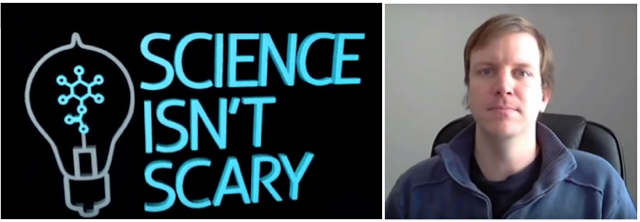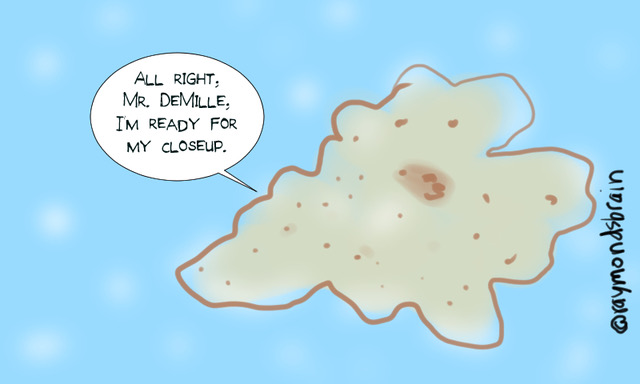Raymond Nakamura, Multimedia co-editor
“I started this,” says chemist Steve Maguire in the introductory video of his YouTube channel, Science Is Not Scary, “because I was sick and tired of dreck masquerading as quality programming.” Now I am not as worked up as Maguire, but as Science Communications Consultant Lisa Willemse emailed, “making and using video to share science ideas is just becoming easier and easier to do.” So for this post, I’ve gathered some tips and observations on making science videos.
Why Video?
“It (video) can explain things in a new way,” emailed Elizabeth Hand, Digital Engagement Specialist at Science World British Columbia, “considering a lot of education is in written form. A new stance on it, a visual stance, can create a new avenue to understanding.” Similarly, scientist turned TV Producer Sarah Chow tweeted me, “I prefer video b/c it stimulates both senses: eyes & ears. In science sometimes you need to see it to believe it.” This difference in appeal can have strategic consequences. Josh Silberg of the Hakai Institute emailed, “Scicomm videos reach a different audience than blogs, podcasts, or public speaking events. There’s definitely overlap in these groups, but video is increasingly becoming an important way that people consume information.” So making a video could be a way to diversify your audience, assuming you have an audience to begin with.
“Scicomm videos reach a different audience than blogs, podcasts, or public speaking events.” — Josh Silberg, Hakai Institute
How video?
So let’s say that you have suitable content for a particular audience, what then? Some sort of script or plan would be useful. And if you are taking different kinds of shots, then you should develop a storyboard, which combines the key images and words. Willemse, who has helped create videos on stem cells for the Ontario Institute for Regenerative Medicine and others, notes, “A storyboard will help you stay focused on the message and ensure that your final video is the length you want.” It’s easier and more time effective to figure things out first rather than trying to cobble something together in editing. Sarah Chow tweeted timeless advice, harkening back to Aristotle, “Have a beginning, middle, & end.” Steve Maguire, in his Canadian Science Publishing blog post for scientists on making science videos says, “Distill your research down to its fundamental points, and then build a story out of it.” If you are a bona fide science communicator, I probably do not need to say that the role of the story needs to be kept in perspective or else you could begin to slide down the slope of the Disney filmmakers who manipulated the poor lemmings into jumping off cliffs. In a post-truth era, try to post “truth.”
As for the approach, Chow recommends, “Start out with a bang! Then explain.” This is a common tactic in science demonstrations and Derek Muller, in his Veratasium videos, often begins with common misconceptions and goes on to correct them. According to his web site, he grew up in Canada and did his Ph.D. “On Designing Effective Multimedia for Physics Education” in Australia. He now resides in the U.S.
As for the execution, “The style, length, and tone of the video will depend on your intended audience,” Silberg says. “Think about your ideal viewer and hone in on a style based on that person.” Maguire, in addressing scientists who might be speaking to the “general public”, notes that using a few carefully chosen, well-defined science words can be part of the learning process, not something to avoid. And in general, various sources noted the importance of keeping it short.

“Distill your research down to its fundamental points, and then build a story out of it.” — Steve Maguire, Science Isn’t Scary
Hand suggests, “The content should always dictate the form,” and that you should use video when “no other form will get the point across better.” Hand comes from the perspective of someone who has the option of using different forms of media. The flip side is that if you have chosen to make a video, make sure that the content you use is suitable.
When the face hits the lens, Maguire has a number of practical tips for presenters, which he acknowledges he does not always manage to follow himself. These include rehearse what you’re going to say, and look into the camera. People who appear to be looking elsewhere, possibly at scripts, can be rather disconcerting. It may take some getting used to seeing yourself on video and you may need to steel yourself to the comments you might receive, if you actually manage to garner some views. As Canadian communications legend Marshall McLuhan famously claimed, “the medium is the message (or sometimes, the massage).” Video can convey messages that you may not even have originally intended. Mitchell Moffit and Gregory Brown, the gay couple who host ASAPScience, say they are not defined by their sexuality, but their ability to deal with haters on YouTube seems to be a remarkable message running in tandem with their primary goal of battling ignorance by celebrating science. But if you can own your personality, then who knows what might happen. Have you ever seen the “Primordial Soup with Julia Child” video? “Don’t be afraid to try new things,” Willemse suggests, “so long as it helps get your message across. You might end up scrapping some of your attempts but you might just as easily end up with something new and fresh.”
“A storyboard will help you stay focused on the message and ensure that your final video is the length you want.” — Lisa Willemse
Style is going to depend on a number of factors which may require more expertise that you can handle, talented as you no doubt are. When addressing a topic, Willemse suggests you ask yourself, “has someone done it as well or better than I can? If so, it might not be worth making the video.” The ASAPScience channel makes different styles of videos – some featuring people talking, some using narration with whiteboard drawings, and some involving songs and other techniques. Silberg points out, “Video production brings together different creative scicomm skill sets, from writing to videography to editing to animation.” The one-minute shorts featured on the Hakai Wild channel usually involve two or three people, where as the longer five to eight minute films about scientific research can involve three to five people. If there is just you, though it is feasible, you’ll just have to be that much smarter. I’m sure you can do it. As far as equipment goes, Willemse says, “Many videos can be shot with a phone and edited with free software.” At the same time, she adds, “if there’s one thing I’d recommend investing in, it would be a good microphone, which you can find for $100-500 depending on what your needs are.”
“Think about your ideal viewer and hone in on a style based on that person.” –Josh Silberg, Hakai Institute
After Video
Now let’s say that you have managed to finish your masterpiece. You might be thinking, “if I post it, they will watch.” Not so fast. According to Silberg, “You have to build up your audience, which often takes more time and effort than initially anticipated.” People involved in education often seem to despair of marketing (or maybe that is just me) but Silberg advises, “Think about how to market the video to your intended audience.” Part of this thinking includes deciding on a video platform. Although YouTube is well known as a video platform, Silberg says, “you have to rack up quite a few views to make any sort of $, so it may be better to go ad free at first until you build up a subscriber base.” Muller has also addressed some of his concerns about the YouTube’s use of algorithms.
In addition to Youtube, the Hakai Institute uses Vimeo, which, Silberg says, “is less likely to be searched within their platform, but allows updates to a video without changing the link.”
And then there’s Facebook, which has come under closer scrutiny for some of its perhaps nefarious practices. Muller has expressed his displeasure with Facebook policies. Silberg says it “doesn’t pay creators and actually requires you to pay to reach your full audience by ‘boosting’ a post.” On a curious technical note regarding videos on Facebook, he adds, “most people watch without sound (so subtitles can be key).” And yet, despite its various drawbacks, he concedes, “if you already have a big following, then it might make sense to post there.”
So making a decent science video may not just be a matter of pressing the record button on your phone. But perhaps these notes will encourage you to look into it a bit more. For one thing, the multimedia category on Science Borealis could use some video posts. And who knows, you could become the next Jill Nye, the Science Person.
Lights! Camera! Action!
*Editor’s Note: Several changes were made to this post at the request of Josh Silberg of the Hakai Institute. Hyperlinks to Hakai’s videos were changed to Hakai’s Youtube channel. The screen capture from the Hakai video was replaced with the actual video. And Silberg clarified that Hakai uses Youtube in addition to Vimeo. (02/20/2017 5:20pm)
*Correction: This piece originally stated that Derek Muller resides in Australia. He resides in the US.





I recently came across Scope of Science, created by Vancouverite Kurtis Baute, in which he explores metaphors of science, such as using dominoes to illustrate the age of the universe.
https://www.youtube.com/channel/UCTRM8LE1g6UXrVZKwgw5oEA